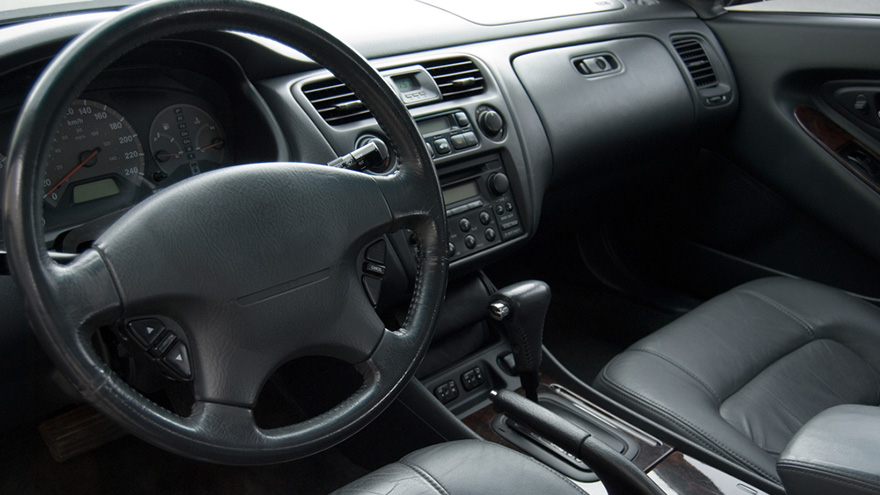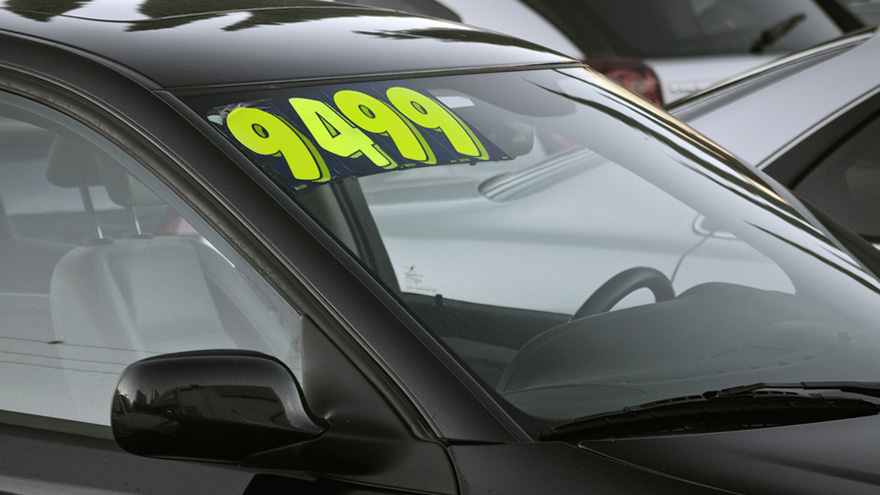Normal things you see in October are here: Children excited about Halloween around the corner, homecoming football games and leaves turning into a brilliant array of colors.
And along with those things, even more good news for dealers: Wholesale prices are behaving typical for October, according to the latest edition of Market Insights from Black Book.
“Used-vehicle values are finally experiencing normal depreciation trends for this time of the year, after being unusually strong since spring,” said Anil Goyal, executive vice president of operations for Black Book.
Volume-weighted, editors indicated that overall car segment values decreased by 0.44 percent last week. In comparison, Black Book noted the market values for cars had decreased by only 0.30 percent on average during the prior four-week period.
Within cars, Black Book found that the near-luxury car segment experienced the biggest drop, sliding by 0.81 percent or $126.
Again volume-weighted, editors determined overall truck segment values (including pickups, SUVs and vans) softened by 0.39 percent last week. In comparison, Black Book pointed out the market values had dipped by 0.17 percent on average during the previous four-week stretch.
In the truck space, Black Book said the midsize crossover/SUV segment performed the worst, dropping by 0.57 percent or $88.
Turning next to what Black Book representatives at sales nationwide observed, the opening anecdote mimicked how happy a child might be for getting extra candy at Halloween.
“A buyer for a new-car store was elated that he can finally acquire vehicles at lower prices at the auction,” Black Book’s lane watcher in Illinois reported.
Check out the other four observations Black Book shared to see how they compare to what you’re experiencing:
— From Michigan: “The only vehicles still pulling the strong money are trucks and all-wheel-drive SUVs.”
— From California: “No-sales have been incrementally higher each week for the past few sales.”
— From Georgia: “The conversion rates were good. In fact, most of the vehicles that didn’t sell seemed to have unrealistic floors.”
— From Tennessee: “The consignment was down and there were a lot of no-sales, producing just an OK sale.”
More than a year later, Hurricane Harvey still is influencing how wholesale prices and used-vehicle sales are analyzed. The record-setting storm that blasted Texas created comparisons that might make metrics appear odd.
According to ADESA Analytical Services’ monthly analysis of wholesale used-vehicle prices by vehicle model class, wholesale used-vehicle prices in September averaged $10,981 — down 0.6 percent compared to August and 0.6 percent lower than September of last year.
KAR Auction Services chief economist Tom Kontos explained prices for the truck model class segments, on average, fell at a similar rate as car prices, supporting his theory that the two groups will tend to move in parity as truck supply outpaces car supply.
In his latest edition of the Kontos Kommentary, he explained how he and the company analyst team are entering the timeframe when Harvey-influenced figures will be involved, especially with their year-over-year examinations.
“As the wholesale used-vehicle market enters the period of time comparable with last year’s hurricane season, wholesale prices will be challenged to meet last year’s high, demand-driven levels,” Kontos said.
“This is reflected in average wholesale prices in September, which fell on both a month-over-month and year-over-year basis, and significantly lower retail used-vehicle sales than last year,” he continued.
“Prices for off-lease units remained strong, however, as upstream remarketing continues to deny volume from physical auctions and causes dealers unable or unwilling to participate in online-only auctions to bid aggressively on the remaining downstream units,” Kontos went on to say, elaborating further in this online video.
A regular part of Kontos’ updates also includes analysis of fleet/lease sales of 3-year-old units with mileage between 36,000 and 45,000 miles. When holding constant for sale type, model-year age, mileage, and model class segment, Kontos discovered prices were up significantly on a year-over-year basis for both midsize cars and midsize SUV/CUVs.
Prices for those midsize cars rose 6.0 percent or $699 to $12,298, while prices for those midsize SUV/CUVs climbed 4.6 percent or $901 to $20,634.
“Midsize car prices continue to outperform prices for midsize SUVs and crossovers, due, as mentioned above, to the incoming supply of trucks outpacing that of cars,” Kontos said.
“The strength of prices for both groups in this analysis indicates, again as mentioned above, that upstream sales are preventing an oversupply of off-lease units from reaching physical auction lots,” he added.
Looking at the September data for the entire market, Kontos shared that average wholesale prices for used vehicles remarketed by manufacturers softened 1.9 percent month-over-month but ticked up 0.7 percent year-over-year.
Kontos noted prices for fleet/lease consignors dipped 1.3 percent sequentially but rose 6.6 percent annually.
Furthermore, he added average prices in September for dealer consignors ticked 0.4 percent lower versus August and 0.3 percent relative to the same month last year.
Kontos closed his latest update by reviewing September sales information he received from the National Automobile Dealers Association and Autodata Corp.
Based on NADA data, Kontos said retail used-vehicle sales by franchised dealers slid 6.3 percent year-over-year in September, and deliveries dropped 8.7 percent for independent dealers.
Kontos also pointed out that September certified pre-owned sales declined 8.9 percent compared to the prior month and 3.9 percent year-over-year, according to figures from Autodata. On a year-to-date basis, he added CPO sales remain up 1.8 percent versus last year.
ADESA Wholesale Used-Vehicle Price Trends
| |
Average |
Price |
($/Unit) |
Latest |
Month Versus |
| |
Sept. 2018 |
Aug. 2018 |
Sept. 2017 |
Prior Month |
Prior Year |
| |
|
|
|
|
|
| Total All Vehicles |
$10,981 |
$11,048 |
$11,046 |
–0.6% |
–0.6% |
| |
|
|
|
|
|
| Total Cars |
$8,617 |
$8,692 |
$8,777 |
-0.9% |
-1.8% |
| Compact Car |
$6,533 |
$6,481 |
$6,681 |
0.8% |
-2.2% |
| Midsize Car |
$7,491 |
$7,590 |
$7,788 |
-1.3% |
-3.8% |
| Full-size Car |
$7,655 |
$7,510 |
$7,243 |
1.9% |
5.7% |
| Luxury Car |
$13,380 |
$13,615 |
$14,016 |
-1.7% |
-4.5% |
| Sporty Car |
$14,327 |
$14,367 |
$13,906 |
-0.3% |
3.0% |
| |
|
|
|
|
|
| Total Trucks |
$12,949 |
$13,040 |
$13,183 |
–0.7% |
-1.8% |
| Minivan |
$8,314 |
$8,222 |
$9,061 |
1.1% |
-8.2% |
| Full-size Van |
$13,365 |
$13,784 |
$13,165 |
-3.0% |
1.5% |
| Compact SUV/CUV |
$10,781 |
$10,765 |
$10,679 |
0.2% |
1.0% |
| Midsize SUV/CUV |
$11,144 |
$11,060 |
$11,424 |
0.8% |
-2.5% |
| Full-size SUV/CUV |
$13,941 |
$13,370 |
$13,742 |
4.3% |
1.5% |
| Luxury SUV/CUV |
$18,285 |
$18,491 |
$19,209 |
-1.1% |
-4.8% |
| Compact Pickup |
$9,981 |
$10,228 |
$9,591 |
-2.4% |
4.1% |
| Full-size Pickup |
$16,317 |
$16,638 |
$16,963 |
-1.9% |
-3.8% |
Source: ADESA Analytical Services. August data revised.
With the wholesale price declines for cars beginning to accelerate, Black Book representatives mingling with dealers in lanes nationwide uncovered five interesting trends; ones that might be happening at your local sale or your favorite online bidding platform, too.
First, let’s look at the numbers included in this week’s edition of Black Book Market Insights.
Volume-weighted, editors indicated overall car segment values decreased by 0.54 percent last week. That’s a much higher pace than what Black Book recorded during the previous four-week span when car values decreased by only 0.16 percent on average.
As what was noted from the previous update, as well, Black Book said the sporty car segment experienced the biggest drop, sliding by 0.91 percent or $140.
Meanwhile the volume-weighted data on the truck side showed segment values (including pickups, SUVs and vans) decreased by 0.37 percent last week. Like cars, truck values are softening at a greater rate since market values had dipped by just 0.10 percent on average during the prior four-week period.
Among trucks, Black Book reported the minivan and small pickup segments performed the worst as minivans dropped by 0.95 percent or $123, and small pickups declined by 0.83 percent or $131.
“The decline in used-vehicle values accelerated steeply last week. There was a broad drop in the market, particularly in the car segments,” said Anil Goyal, executive vice president of operations for Black Book.
And finally, here are those observations from throughout the country. See what matches up to your recent experience.
— From Florida: “The buyers were picky as they seem to be doing less speculating for inventory. Trucks continue to perform well here.”
— From Washington: “A more normal fall sale as prices seemed to soften on most vehicles. The dealers that I spoke with were enjoying the decline in values along with a good run of vehicles to choose from.”
— From Illinois: “Representatives from two of the largest remarketers stated they are seeing proceeds come down.”
— From Georgia: “There may be a new pattern emerging: Higher mileage and lower condition vehicles more in demand over the cleaner vehicles.”
— From Wisconsin: “We had more no-sales than usual today along with more vehicles in poor condition.”
After five years of ownership, the average vehicle is worth about half of what its value was as a new car.
But for one clear leader in the clubhouse, you can nearly cut that depreciation in two.
According to an analysis from iSeeCars.com, the four-door Jeep Wrangler Unlimited loses 27.3 percent of its value in the first five years.
That was good enough to top the iSeeCars list of vehicles with the lowest five-year depreciation.
Second on the list?
The two-door Wrangler, whose depreciation was just “a fraction of a percentage point” higher, iSeeCars noted.
“Jeeps are known for retaining their value due to their enduring popularity, as well as their durability and performance across all terrains,” iSeeCars chief executive Phong Ly said in the analysis.
Three pickup trucks followed: the Toyota Tacoma (29.5 percent), Toyota Tundra (37.1 percent) and Nissan Frontier (37.8 percent).
The back half of the top 10 list was also trucks and SUVs, for the most part. The Toyota 4Runner was sixth at 38.1 percent, followed by the Chevrolet Silverado 1500 (39.7 percent) and GMC Sierra 1500 (39.9 percent), respectively.
To determine this list and others in its report, iSeeCars looked at over 3.6 million 2013 model-year vehicles sold that same year. It also examined over 750,000 cars from the 2013 model year that were sold in the first nine months of 2018.
“Cars with outlier pricing were removed, as were heavy-duty trucks and vans and models no longer in production as of the 2018 or 2019 model year. Only models where depreciation was accurate to within +/- 0.5 percentage points were used in the final analysis,” the company explained in its methodology. “Used-car prices from 2018 were inflation-adjusted by 7 percent to 2013 dollars, based on data from the U.S. Bureau of Labor Statistics.”
Continuing on, No. 9 on the list was the Subaru Impreza, which was the only car to make the list and had 42.3 percent deprecation after five years.
Rounding out the Top 10 was the Ram 1500 (42.7 percent).
“While the average new vehicle loses 50.2 percent of its value after five years, there are vehicles that retain more of their value and depreciate less than average,” Ly said.
“For consumers who buy new vehicles and sell them around the five-year mark, choosing a model that retains the most value is a smart economic decision,” he said.
But for Wrangler owners, they may not be willing to part with their Jeeps after five years, given their passion for the vehicle.
You might even call the Wrangler a cult classic.
“And it keeps growing, though … it’s a cult vehicle, but that cult keeps attracting more and more people,” Jonathan Banks, who is vice president of vehicle analysis and analytics for J.D. Power, said in a phone interview last month.
“And you would assume as we continue to migrate towards more trucks and SUVs, that becomes the icon,” Banks said. “I expect it to be the leader in the segment for many years to come.”
The 2018 model-year Wrangler is projected to retain 62.3 percent of its value after 36 months, according to J.D. Power’s residual value forecast for September/October.
That’s nearly 15 percentage points higher than the segment average of 47.4 percent.
“The Wrangler has always had this kind of appeal in the used market,” Banks said. “It’s really the unique value proposition that vehicle offers.
“It basically has a loyal and very passionate following that has enabled the Wrangler to not only be appealing to people that actually use it for what it’s built for, but it’s become this completely emotional product even for people that don’t really use it for off-roading,” he said.
During his two decades in the auto industry, Banks has seen the Wrangler maintain “phenomenal” resale values, as it is “always that vehicle up at the top,” he said.
And to be fair, there have been other models with “glimpses” of such strength, like the Toyota FJ Cruiser, Land Rover Defender as well as the Nissan Xterra “to some extent, when it went away,” Banks said.
He said, “there’s just a real appeal for U.S. consumers for this rugged-looking vehicle that actually has the capability to perform in line without looks.”
For the Wrangler, that performance is driven by an emotional connection-sparked demand that outweighs the supply.
He doesn’t expect that to change, barring something drastic, and perhaps unwise.
“That DNA of that vehicle is just something that shouldn’t be messed with,” Banks said. “It’s like the perfect vehicle for that customer.”
With pumpkins permeating everything from lattes to yard décor, the appeal of summertime vehicles, especially sporty cars, is softening.
This week’s edition of Black Book Market Insights showed the premium sporty car segment experienced the biggest drop, sliding by 0.53 percent or $209.
Reviewing overall car segment values, editors found their volume-weighted information represented a decrease of 0.21 percent last week. In comparison, Black Book noted the market values of cars had decreased by just 0.09 percent on average during the prior four-week period.
Again volume-weighted, Black Book determined overall truck segment values — including pickups, SUVs and vans — softened by 0.16 percent last week. Editors indicated truck market values had decreased by 0.07 percent on average during the previous four-week span.
Among trucks, the report showed the full-size luxury crossover/SUV segment performed the worst, declining by 0.61 percent or $192.
“Overall, wholesale market values were relatively steady last week with the exception of some luxury and sporty car segments,” said Anil Goyal, executive vice president of operations for Black Book, who is among the collection of experts scheduled to share perspectives during Used Car Week 2018, which begins Nov. 12 at the Westin Keirland Resort and Spa in Scottsdale, Ariz.
Moving along to observations Black Book collected by attending nearly 60 sales nationwide, lane watchers touched on autumn arriving and how dealers are turning the metal they acquire at auction. Here is the rundown:
— From Tennessee: “Retail sales are slow, indicating a return to the more normal fall automotive season. Compact SUVs were the big attraction at the auction today.”
— From Massachusetts: “Today marked the first time in a long time that I heard the term ‘market adjustment’ mentioned. Prices across the board were just OK.”
— From Michigan: “The weather has turned more fall-like setting the tone for a softer market. Dealers were reporting a weaker retail market this week.”
— From Indiana: “Dealers are still buying as business remains strong especially for the nice, cleaner units.”
— From Illinois: “The auctioneers and several remarketers noted that prices were down slightly.”
Update on the specialty markets
The latest analysis from Black Book also included its monthly view of how the specialty markets are behavior. Editors summarized things this way:
— Collectible cars: When “Smokey and the Bandit” was released, Black Book pointed out that performance cars were at a low point, and the Pontiac Trans Am was really the only one still in the game. “The exposure it received revitalized the entire genre and made fast cars ‘cool’ again, leading to a resurgence we are still enjoying to this day,” editors said.
— Recreational vehicles: Black Book noted that the average selling price of towables at auction last month dropped nearly 10 percent, “which is a surprise, given their recent market trends.” Editors went on to say that “it’s important to note that they are still above where they were three months ago, and roughly the same as they have been for most of the year.”
—Powersports: Black Book said overall pricing in the Powersports market is mostly steady this month, with several segments that normally decline this time of year actually ticking up “a little bit.”
— Heavy duty: Editors noticed that buyers with equipment needs continue to pay for good spec, low-mileage trucks. “But they need to be more flexible as the real low mileage trucks become rare,” editors added.
— Medium duty: Editors closed by stating, “We’ve seen less depreciation on the older units mainly due to a limited supply and increased demand.”
Following an 11-week “summer bounce” in Manheim Market Report prices, September ended up being the third consecutive month of record used-vehicle values, according to Cox Automotive's news release and analysis accompanying the latest Manheim Used Vehicle Value Index.
And though weekly prices evened out during the month, analysts are still expecting lofty used-vehicle prices to continue.
That’s driven by lower supply and projections for SUV volume to increase at auction, Cox said.
The Manheim Used Vehicle Value Index was up 3.7 percent year-over-year in September, reaching an all-time high of 139.9.
Compact cars, whose prices were up 7.1 percent year-over-year, and midsize cars (up 4.4 percent) led the way in terms of price growth for September.
Sedans like those have dominated auction volumes this year, with over half of the supply being sedans, according to Cox Automotive. Less than a third have been SUVs (and SUV/CUV prices were up 2.7 percent last month).
But that is likely to change.
“SUV volume, however, is growing, while car volume shrinks following the trend in the new-vehicle market. Especially for consumers seeking an affordable solution to higher vehicle prices and interest rates, sedans have been becoming more attractive,” Cox Automotive analysts indicated.
“However, the supply of sedans in the new-vehicle market is near a six-year low, making them more in demand in the used market.”
Beyond the 3.7 percent overall year-over-year increase in used-car pricing for September, luxury cars were up 0.1 percent, pickups climbed 2.4 percent, SUV/CUVs were up 2.7 percent and vans were up 1.2 percent.
That may be reminiscent of last autumn’s wholesale bump, which came after hurricanes. But the underlying cause is different.
“The strong wholesale prices we saw in the fall of 2017 were driven mostly by major hurricane activity, causing significant vehicle loss in Texas and Florida,” Cox Automotive chief economist Jonathan Smoke said in the analysis.
"This year, the abnormal rise in value seems to be mostly man-made, driven primarily by consumer demand, rising interest rates, and threats of tariffs,” he said. “Consumers and dealers alike had reason to believe the cost of buying a vehicle would be more expensive later in the year, so there was a strong sense of urgency and 'buy now' mentality in both new and used.”
Smoke will be among the array of economists, analysts and other market experts on tap to speak at Used Car Week, which is being held Nov. 12-16 at the Westin Kierland in Scottsdale, Ariz.
RVI Group elevated one of its experts this week to lead its passenger vehicle insurance and analytics businesses.
Now under the leadership of Wei Fan, the firm announced its passenger vehicle insurance and quantitative analysis teams — which partner closely on business development and operations of RVI Analytics — are being consolidated. The company explained this move will allow RVI to capitalize on the analytics business including its Used Vehicle Price Index (UVPI) data subscription products.
RVI Analytics was launched earlier this year in partnership with Maryann Keller & Advisors (MK&A) — also a member of the Automotive Intelligence Council. The company is looking to offer comprehensive industry analytics for firms with automotive-related interests.
Management went on to state this operational consolidation will create efficiencies and improve RVI Analytics' ability to provide industry leading services to its clients, especially the accurate assessment of risk in used-vehicle prices, providing critical input to capital markets, lenders and lessors.
“Bringing these teams together will allow us to be more agile, better serve our customers and improve our execution through increased collaboration,” said Michael McGroarty, co-chief operating officer of RVI Group.
“We are presenting more comprehensive used-vehicle price index data than anyone else in the industry, and I am confident that this streamlined structure will position us for optimal performance going forward,” McGroarty continued.
Prior to joining RVI, Fan was the director of Used Vehicle Market Solutions for J.D. Power & Associates. Since 2007, Fan has had extensive experience with RVI’s passenger vehicle insurance and analytics business as the head of the quantitative analysis team.
“With an excellent track record at RVI, Wei is uniquely qualified to lead the passenger vehicle and analytics businesses at RVI. I look forward to their success,” said Douglas May, chief executive officer of RVI Group, which is among the companies set to be a part of Used Car Week 2018 — Education, Celebrations, Technology and Connections.
Discussions about wholesale pricing and elements through the remarketing chain are on tap for Used Car Week, which begins Nov. 12 at the Westin Keirland Resort and Spa in Scottsdale, Ariz.
Early bird discounts are available through Oct. 16. Complete details can be found at www.usedcarweek.biz.
Perhaps the first autumn leaves are starting to fall on your lot. And according to Black Book, so are car prices.
The latest Black Book Market Insights Report highlighted that car segment depreciation has accelerated during the past two weeks, with sporty cars, midsize cars and full-size cars seeing some of the largest weekly depreciation since the start of the year.
Based on volume-weighted information, editors determined overall car segment values decreased by 0.25 percent last week. In comparison, the market values had decreased by only 0.02 percent on average during the prior four-week period.
With summertime officially in the rear-view mirror, Black Book noticed that the sporty car segment experienced the biggest drop, sliding by 0.36 percent or $56.
Values for midsize cars dipped by 0.33 percent or $29, and values for full-size cars ticked 0.32 percent or $37 lower.
Looking at volume-weighted data from the truck side, editors indicated overall truck segment values — including pickups, SUVs and vans — decreased by 0.13 percent last week. In comparison, the market values had declined by only 0.06 percent on average during the prior four-week period.
Within trucks, Black Book noticed the full-size luxury crossover/SUV segment performed the worst, deteriorating by 0.33 percent or $104.
Turning next to observations from Black Book’s personnel stationed at nearly 60 weekly sales nationwide, activity in the lanes picked up depending on what kind of vehicle crossed the block. Here is the rundown:
— From Michigan: “Cars with above-average mileage are softening somewhat. Truck prices are still really strong, but many believe that they have reached the top of the market.”
— From Indiana: “Retail is still good, which is dictating the wholesale market as is the continued low supply at auction.”
— From Florida: “The finance companies are able to sell their late model vehicles for good money. The older cars are struggling, even those in average condition.”
— From South Carolina: “Sellers are holding their floors, which resulted in more no-sales today. There also didn’t seem to be as much urgency to buy.”
— From Texas” “Overall a really good day with brisk bidding, which resulted in a good sales percentage and strong prices.”
Perhaps the industry is taking its collective foot off of the gas in regards to wholesale car prices.
Black Book shared in its latest Market Insights report that overall car segment values decreased by 0.20 percent last week. In comparison and reflecting the unusual summer it has been at the auction, volume-weighted car values had increased at an average rate of 0.05 percent per week during the previous two weeks.
Meanwhile, editors noticed overall truck segment values — including pickups, SUVs and vans — remained nearly flat last week. In comparison, the volume-weighted truck values had decreased at an average rate of 0.06 percent per week during the previous two weeks.
Among car segments, Black Book found that prestige luxury car and full-size car values decreased the most last week. Prestige luxury cars dropped by 0.51 percent or $171, and full-size cars dipped by 0.37 percent or $51.
Among truck segments, editors noticed that compact van values decreased the most last week, sliding by 0.89 percent or $81.
Meanwhile, Black Book’s anecdotes from the lanes collected and shared by its nearly 60 representatives at weekly sales nationwide shed light on how bidding activity might be decelerating as well. Here is the latest rundown:
— From Texas: “Prices are holding steady, which has some of the buying dealers expressing angst. They are accustomed to the typical fall drop-off, which hasn’t happened.”
— From Florida: “Vehicles with higher miles and questionable history reports continue to struggle on the dealer lanes.”
— From Arizona: “Our market seems to be slowing a bit as the sale started really strong but soon fizzled out.”
— From Georgia: “Bidders backed away from the really high floors. Passenger cars sold really well.”
— From Pennsylvania: “Still a very positive mood among the dealers here, but many expect a slight downturn soon.”
The unusual summertime wholesale price movements seen by both KAR Auction Services and J.D. Power Valuation Services might push the costs that dealers face in the lanes nearly 3 percent higher by the time the year ends.
The August price updates from both companies conveyed notable wholesale price surges, with KAR chief economist Tom Kontos calling the situation in an online video that accompanied his analysis, “a perfect storm for the used-car market in August as retail sales and wholesale values were both strong.”
He added in his latest Kontos Kommentary that, “Retail demand and upstream remarketing were key contributors to wholesale used vehicle price growth in August, as prices were up on a month-over-month and year-over-year basis.”
According to ADESA Analytical Services’ monthly analysis of wholesale used-vehicle prices by vehicle model class, wholesale values in August averaged $11,049, which marked a 1.4-percent rise compared to July and a 0.9-percent lift relative to August of last year.
Kontos said car prices in total went up 2.2 percent month-over-month, while truck prices rose 1.0 percent, “indicating that car segments are now in better supply-demand balance.”
Meanwhile the team at J.D. Power Valuation Services shared through their latest installment of Guidelines that August prices “ended the month even stronger than expected.”
The J.D. Power Valuation Services’ Seasonally Adjusted Used Vehicle Price Index increased 2.2 points on a sequential basis to land at 121.9. The reading also jumped 6.3 points year-over-year.
The August index rise represented an increase for the third consecutive month, leaving the reading at the highest level since late 2015.
“The used-vehicle market starting showing its strength in the middle half of 2017, and there are no signs of it letting up,” analysts said in Guidelines. “Most of the market’s left in prices has been driven by mainstream car growth, however, mainstream utility segments continue to show firmness as well.”
J.D. Power Valuation Services elaborated about August car performance, noting that small-car prices rose 2 percent and prices for midsize cars ticked up by 1.5 percent.
Jonathan Banks, the company’s vice president of vehicle analysis and analytics, detailed what’s happening outside of the lanes that’s impacting car prices during a phone conversation with Auto Remarketing earlier this month
“Incentive spending is still a bit higher than what you would like to see. The car segments are still a little misaligned, but it’s getting a lot better. It was nice to see what Honda did with the Accord when sales didn’t meet their expected demand. You expect that from Honda,” said Banks, who along with Kontos are among the collection of experts on tap for Used Car Week 2018, the series of industry-leading conferences that begin on Nov. 12 in Scottsdale, Ariz.
“I think we’ve reached the point where if manufacturers keep production in line with the sales we’ve been seeing the past three or four months, I think they’re pretty close, we’re seeing that people still want cars,” Banks continued. “But I think pulling back in production was the right thing to do. You would like to see incentives around 10 percent for cars, but we’re not quite there yet.”
While mainstream car prices are helping to push overall figures higher, J.D. Power Valuation Services explained why the same situation cannot be said about luxury vehicles. Again from the latest installment of Guidelines, analysts pointed to higher incentive spending as the headwind.
Turning back to Kontos and the August information from KAR, he indicated average wholesale prices for used vehicles remarketed by manufacturers rose 3.2 percent month-over-month and 2.0 percent year-over-year.
Kontos noted prices for fleet/lease consignors were up 1.5 percent sequentially and up 8.2 percent annually.
He added that average prices for dealer consignors ticked up 1.9 percent versus July and 0.6 percent compared to August of last year.
And with regard to the other ingredient for that “perfect storm,” Kontos cited data from the National Automobile Dealers Association that showed retail used vehicle sales by franchised dealers increased 4.5 percent year-over-year in August.
The rise for independent dealers was even more robust as Kontos put the year-over-year jump at 9.8 percent.
Kontos went on to mention figures from Autodata, Corp. that revealed August certified pre-owned sales 4.9 percent from the prior month and 1.8 percent year-over-year. According to Autodata, on a year-to-date basis, CPO sales are up 2.5 percent versus last year.
So with all of that activity in mind, J.D. Power Valuation Services sees wholesale prices rising by 2.9 percent by the end of 2018. Analysts acknowledged the climb might not be that much if negative price factors such as incentives, rising supply, worsening credit conditions and a jump in gas prices play bigger roles. However, they think positive factors — favorable labor conditions, strengthening housing prices and long-term quality improvements — outweigh negatives.
“There are two primary factors why the used market continues to heat up,” analysts said in Guidelines. “First, dealers are placing more emphasis on used-vehicle operations, and second, vehicle affordability is becoming increasingly important to consumers.”
Senior editor Joe Overby contributed to this report.
CORRECTION: Story is updated with reference to NIADA corrected to NADA.
ADESA Wholesale Used-Vehicle Price Trends
| |
Average |
Price |
($/Unit) |
Latest |
Month Versus |
| |
July 2018 |
June 2018 |
July 2017 |
Prior Month |
Prior Year |
| |
|
|
|
|
|
| Total All Vehicles |
$10,902 |
$10,895 |
$10,887 |
0.1% |
0.1% |
| |
|
|
|
|
|
| Total Cars |
$8,519 |
$8,548 |
$8,613 |
-0.3% |
-1.1% |
| Compact Car |
$6,434 |
$6,441 |
$6,582 |
-0.1% |
-2.3% |
| Midsize Car |
$7,457 |
$7,533 |
$7,633 |
-1.0% |
-2.3% |
| Full-size Car |
$7,275 |
$7,495 |
$7,018 |
-2.9% |
3.7% |
| Luxury Car |
$13,294 |
$13,172 |
$13,582 |
0.9% |
-2.1% |
| Sporty Car |
$14,225 |
$14,515 |
$14,164 |
-2.0% |
0.4% |
| |
|
|
|
|
|
| Total Trucks |
$12,922 |
$12,901 |
$13,058 |
0.2% |
-1.0% |
| Minivan |
$7,937 |
$8,652 |
$8,604 |
-8.3% |
-7.7% |
| Full-size Van |
$13,306 |
$13,202 |
$11,875 |
0.8% |
12.1% |
| Compact SUV/CUV |
$10,805 |
$10,829 |
$10,467 |
-0.2% |
3.2% |
| Midsize SUV/CUV |
$10,992 |
$11,135 |
$11,402 |
-1.3% |
-3.6% |
| Full-size SUV/CUV |
$13,198 |
$13,499 |
$13,353 |
-2.2% |
-1.2% |
| Luxury SUV/CUV |
$18,495 |
$18,331 |
$19,099 |
0.9% |
-3.2% |
| Compact Pickup |
$9,796 |
$9,471 |
$9,615 |
3.4% |
1.9% |
| Full-size Pickup |
$16,583 |
$16,386 |
$17,061 |
1.2% |
-2.8% |
Source: ADESA Analytical Services.












